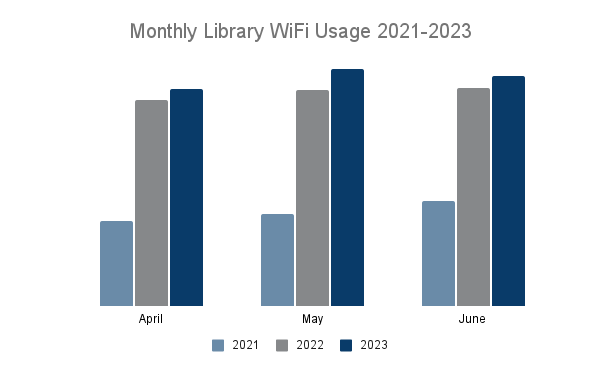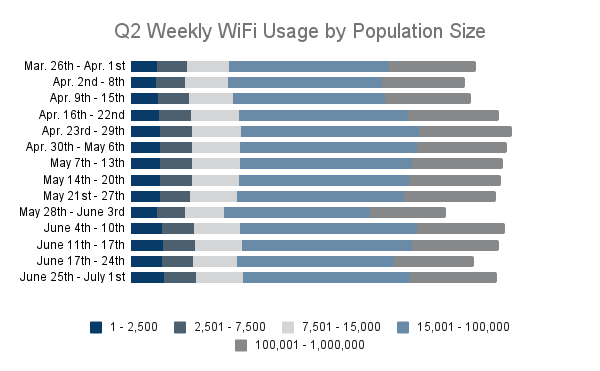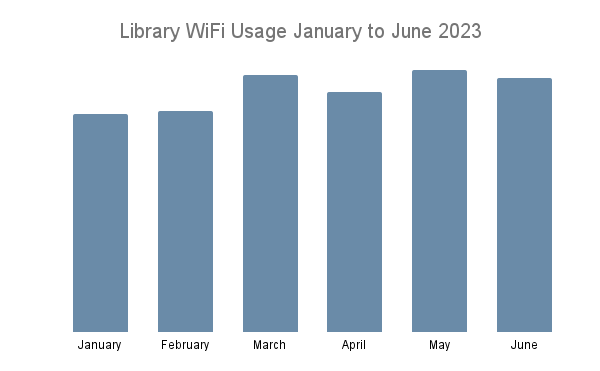Q2 2023 Library WiFi Usage and Digital Equity Trends
The second quarter of 2023 continued to demonstrate the significance of public library WiFi usage in advancing digital equity and bridging the digital divide. As communities returned to a sense of normalcy following the COVID-19 pandemic, there was a slight increase in WiFi usage this quarter compared to last year. While this increase was smaller than the growth observed from 2021 to 2022, notable trends emerged, reflecting the ongoing efforts of libraries to meet changing community needs. This analysis explores the implications of the latest data, highlighting how libraries are leveraging BEAD funding to provide broadband access and their role in facilitating communication about new broadband connections.
Q2 2023 WiFi Usage and Travel Trends
During the second quarter of 2023, public library WiFi usage saw a slight increase, which was not as substantial as the growth observed from 2021 to 2022. This trend can be attributed to the gradual return to pre-pandemic norms and increased travel activities during the Summer season.
Evidence suggests that more people returned to vacation destinations this quarter compared to previous years. Despite this travel trend usage in other areas remained high as well. This could possibly be attributed to the in person programs libraries put on in full force this year. Offering engaging activities and resources to the community, engaging programs continue to draw in patrons throughout the quarter. These programs may have a role in offsetting the impact of travelers, ensuring that libraries continue to serve as essential information access points for those in the community.
BEAD Funding Deployment Preparations
Libraries across multiple states have been proactive in partnering with state authorities to develop strategies for utilizing Broadband Equity Access and Deployment (BEAD) Program funding effectively. The National Telecommunications and Information Administration (NTIA) announced funding allocations in late June providing states and localities with crucial information to start preparing budgets for broadband deployment.
BEAD funds are expected to be used to improve broadband access not only within library premises but also extending broadband coverage through their locations to reach underserved communities. Many libraries are positioning themselves as communication points to disseminate information about newly available broadband connections in their states. This proactive role further cements libraries’ status as digital equity advocates and crucial community anchors in the journey towards universal connectivity. If you would like to read more you can check out our post from earlier in the quarter, click here!
The Impact of Programs on WiFi Usage
During the second quarter of 2023 we continued to see patrons utilizing libraries and their services. Despite the Summer season being associated with increased travel and outdoor activities, libraries witnessed sustained high WiFi usage. This success may be attributed to the engaging nature of programs that attracted patrons to visit libraries regularly throughout the quarter.
Summer programs and reliable WiFi access provided by libraries continue to reinforce the role libraries play as essential sources of information, learning, and community engagement. The sustained usage during this period highlights the ongoing importance of public libraries in fostering digital literacy and connectivity.
What Does the Future Hold for Public Library WiFi?
The second quarter of 2023 reaffirmed the crucial role of public libraries in promoting digital equity and bridging the digital divide. Smaller incremental increases continue as the world returns to a new normal this quarter and libraries’ efforts to provide reliable internet and engaging communities continue to make a significant impact on their communities.
As libraries collaborate with states to utilize BEAD funding for broadband deployment, they are poised to play an even more active role in extending connectivity and serving as key information hubs for the unserved and underserved. The combination of programs and WiFi access has strengthened libraries’ positions as vital community assets, ensuring equitable access to digital resources and technology.
The future of public libraries is in good hands with libraries continuously adapting to meet evolving community needs and technology developments. By embracing the opportunities presented by the NTIA and fostering partnerships with states, libraries will continue to play a critical role in providing equitable access to the internet.




